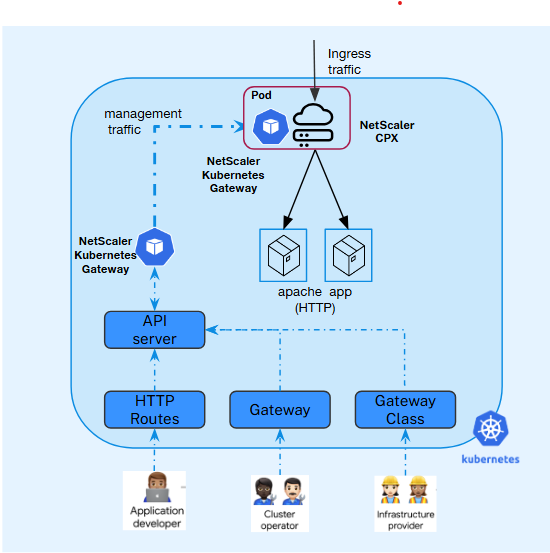Deploy NetScaler® CPX Kubernetes Gateway Controller
The deployment process involves deploying the Gateway Controller, which monitors and manages Gateway CRDs that define traffic routing rules. The Gateway Controller then configures the NetScaler CPX to direct external requests to the sample application.

-
Deploy a sample application to get started.
apiVersion: apps/v1 kind: Deployment metadata: name: cnn-website labels: name: cnn-website app: cnn-website spec: selector: matchLabels: app: cnn-website replicas: 2 template: metadata: labels: name: cnn-website app: cnn-website spec: containers: - name: cnn-website image: quay.io/sample-apps/cnn-website:v1.0.0 ports: - name: http-80 containerPort: 80 - name: https-443 containerPort: 443 --- apiVersion: v1 kind: Service metadata: name: cnn-website labels: app: cnn-website spec: type: NodePort ports: - name: http-80 port: 80 targetPort: 80 - name: https-443 port: 443 targetPort: 443 selector: name: cnn-website <!--NeedCopy--> -
Install the Gateway API CRDs from the official standard channel if they are not already installed.
-
Generate
values.yamlbased on your use case. For information about the mandatory and optional parameters that you can configure during NetScaler Kubernetes Gateway Controller installation, see Configurations.gatewayController: entityPrefix: gwy gatewayControllerName: "citrix.com/nscpxgw-controller" license: accept: yes service: annotations: {} spec: type: NodePort ports: - port: 80 targetPort: 80 protocol: TCP name: http - port: 443 targetPort: 443 protocol: TCP name: https <!--NeedCopy-->Note:
entityPrefixandgatewayControllerNameare mandatory and must be unique for every deployment of NetScaler CPX with Kubernetes Gateway Controller. -
Deploy the NetScaler CPX with Kubernetes Gateway controller using the Helm charts and the
values.yamlgenerated in preceding step. For more information, see NetScaler CPX with Kubernetes Gateway Controller deployment using Helm Chart.helm repo add netscaler https://netscaler.github.io/netscaler-helm-charts/ helm install cpx-gateway-controller netscaler/netscaler-cpx-with-gateway-controller -f values.yaml <!--NeedCopy-->
Sample Gateway and HTTPRoute CRD
The following is an example of a GatewayClass, Gateway, and an HTTPRoute definition.
-
Create a GatewayClass resource to define the controller handling Gateway objects.
Sample GatewayClass
apiVersion: gateway.networking.k8s.io/v1 kind: GatewayClass metadata: name: example-gateway-class spec: controllerName: citrix.com/nscpxgw-controller <!--NeedCopy--> -
(Optional) Create a self-signed SSL certificate and a key to be used with the Gateway-Listener for TLS configuration.
The following command is just a sample command to create a self-signed certificate and assumes that the host name of the application is
example.com.openssl genrsa -out cnnwebsite_key.pem 2048 openssl req -new -key cnnwebsite_key.pem -out cnnwebsite_csr.pem -subj "/CN=example.com" openssl x509 -req -in cnnwebsite_csr.pem -sha256 -days 365 -extensions v3_ca -signkey cnnwebsite_key.pem -CAcreateserial -out cnnwebsite_cert.pem <!--NeedCopy-->Note:
If you already have an SSL certificate, you can create a Kubernetes secret using the same.
-
Create a Kubernetes Secret to store the SSL certificate and key (TLS pair).
kubectl create secret tls app1-secret --key cnnwebsite_key.pem --cert cnnwebsite_cert.pem <!--NeedCopy--> -
Define a Gateway resource to expose services based on defined listeners.
apiVersion: gateway.networking.k8s.io/v1 kind: Gateway metadata: name: example-gateway spec: gatewayClassName: example-gateway-class listeners: - name: http protocol: HTTP port: 80 - name: https protocol: HTTPS port: 443 tls: mode: Terminate certificateRefs: - kind: Secret name: app1-secret group: "" <!--NeedCopy-->Notes:
- Verify that the gatewayClassName defined in the Gateway matches the GatewayClass resource that is created in the preceding step.
-
Apply HTTPRoute or other route CRDs to route traffic to backend services.
apiVersion: gateway.networking.k8s.io/v1 kind: HTTPRoute metadata: name: example-route spec: parentRefs: - name: example-gateway hostnames: - "example.com" rules: - matches: - path: type: PathPrefix value: / backendRefs: - name: cnn-website namespace: default port: 80 <!--NeedCopy-->Notes:
- Ensure that the gateway name specified in
parentRefsmatches with the Gateway CRD established in the preceding step. - Currently, the HTTPRoute CRD only supports a single
parentRef.
- Ensure that the gateway name specified in
-
Verify the gatewayClass status. If the status shows
ACCEPTED: True, then the controller has accepted the resource.kubectl get gatewayclass NAME CONTROLLER ACCEPTED AGE example-gateway-class citrix.com/nscpxgw-controller True 2d <!--NeedCopy-->kubectl describe gatewayclass ... Spec: Controller Name: citrix.com/nscpxgw-controller Status: Conditions: Last Transition Time: 2025-10-16T06:24:51Z Message: Accepted by the controller. Reason: Accepted Status: True Type: Accepted Events: <none> <!--NeedCopy-->Verify the Gateway resource status. If the status shows
PROGRAMMED : True, then controller has successfully pushed the configuration to NetScaler.kubectl get gateway example-gateway NAME CLASS ADDRESS PROGRAMMED AGE example-gateway example-gateway-class 10.244.2.28 True 14m <!--NeedCopy-->kubectl describe gateway example-gateway Status: Addresses: Type: IPAddress Value: 10.244.2.28 Conditions: Last Transition Time: 2025-10-16T06:24:53Z Message: Accepted by the controller. Reason: CreatedCRDInstance Status: True Type: Accepted Last Transition Time: 2025-10-16T06:25:01Z Message: Config pushed by the controller. Reason: ConfigPushedToNetscaler Status: True Type: Programmed Events: <none> <!--NeedCopy--> -
For traffic, as service of CPX is deployed as
nodePort, you can usenodeIP:NodePortto send the traffic.kubectl get svc -o wide NAME TYPE CLUSTER-IP EXTERNAL-IP PORT(S) AGE SELECTOR cpx-gateway-controller-cpx-service NodePort 10.104.175.74 <none> 80:31375/TCP,443:31994/TCP 11m app=cpx-gateway-controller-netscaler-cpx-with-gateway-controller <!--NeedCopy-->curl -vik --resolve example.com:<nodePort>:<nodeIP> https://example.com:<nodePort> curl -vik --resolve example.com:31994:<nodeIP> https://example.com:31994 <!--NeedCopy-->